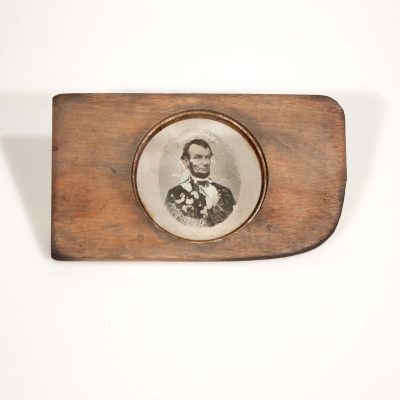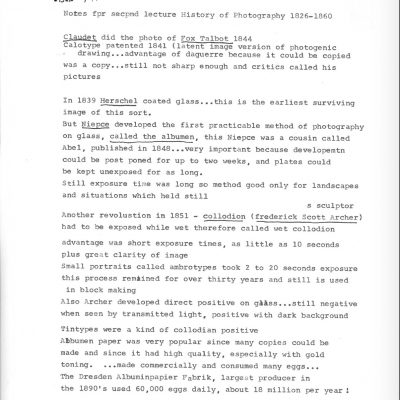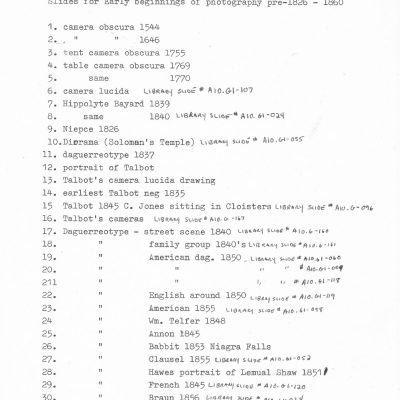
Although photography emerged in the 19th century and soon swept up the world in new practices of image-making, the study of photography as a fine art came later. Photography in its early years was tied to chemical process and its association with scientific discovery, and it was most widely used for capturing portraits in professional photography studios. But as time went on, it became more widely accepted as its own art medium with the unique capacity to transform reality, to fix a moment in time into a printed object. By the 20th century, the practice and study of photography had moved from being a primarily technical skill to a more conceptual one. The first photography exhibitions at art galleries occurred in New York and Europe in the early 1900s, and the reproducible image became the focus of cultural scholars interested in the social consequences of a newly activated visual field.
For most early photographers, education took place through apprenticeship and experimentation. However, as art education started to extend beyond its traditional emphasis on drawing, sculpture, and painting, photography took its place in the new curriculum. It was incorporated as a medium in its own right, and often documented its own integration into the art world. At the Bauhaus, for example, “entire careers were made in photography taken during “off hours,” such as group portraits of students perched on the dormitory balcony or relaxing on the sand.” 1 Still, it was not until after World War II that the first fine arts photography department was founded in the US.
The department Elaine Mayes ran with Jerome Liebling was not only the first to teach photography and film in conjunction, but it was also one of the earliest photography departments at a liberal arts institution. When Mayes arrived at Hampshire, she taught from just two books: Beaumont Newhall’s History of Photography and Helmut Gernsheim’s A Concise History of Photography. Photography criticism was in short supply in the early 1970s—many texts now considered seminal in the theory of photography, such as Susan Sontag’s On Photography and Roland Barthes’ Camera Lucida, would not be published for at least another decade. But the department anticipated the proliferation of critical studies regarding photography. Mayes, Liebling and later Hampshire professors spent less time explaining technical practices and more on emphasizing conceptual and artistic integrity, encouraging their students to experiment freely and develop their own body of work. Lectures would involve looking at slides of historical photographs, and critiques brought together all photography, film, and early video students in one room. These methods influenced generations of photographers and filmmakers.
Hampshire has witnessed and participated in major developments in photography and film pedagogy over the past half-century. Many notable photographers and filmmakers have come to Hampshire to teach throughout the decades, including Diane Arbus, Helen Levitt, Richard Leacock, Bill Brand, and Carrie Mae Weems (who cites Laura Mulvey’s “Visual Pleasure and Narrative Cinema” as the essential text from her time here). Current Hampshire faculty teach production classes that integrate art history and photography theory, and the college now possesses the Robert Lisle Collection of Historic Photography, an extensive resource including books, photographs, cameras, and photography equipment spanning over 150 years. In the words of photographer and critic Mark Wyse, “we shift from an understanding of photography as testimonial witness to the world to a realization that photographs are byproducts of undisclosed forces that alter and determine our relationship to them.” 2 Photography can now be taught not only as a distinct art medium, but as a cultural phenomenon that seeps into social and political life, science, the humanities, and all other forms of visual media.
1. Matthew S. Witkovsky. “Face Time.” In Mitra Abbaspour, Lee Ann Da ner, and Maria Morris Hambourg, eds. Object:Photo. Modern Photographs: The Thomas Walther Collection 1909–1949. An Online Project of The Museum of Modern Art. New York: The Museum of Modern Art, 2014.
2. Mark Wyse. “Too Drunk to Fuck: On the Anxiety of Photography.” In Cotton, Charlotte and Klein, Alex, eds. Words Without Pictures. A Los Angeles County Museum of Art Publication. November 2007-February 2009.





